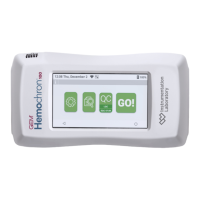1 - Introduction
13 / 112
000HZ6006EN.US • 02 • GEM Hemochron 100 Operator Manual
12 / 112
000HZ6006EN.US • 02 • GEM Hemochron 100 Operator Manual
1
Introduction
1.1
Intended Use
The GEM Hemochron 100 system is a battery‑operated, portable instrument that performs individual
in vitro
quantitative coagulation tests on fresh whole blood. The system is intended to be used with test cartridges
available from the manufacturer and include tests for Activated Clotting Time (ACT+) and Low Range Activated
Clotting Time (ACT-LR). The system is intended for use only in point-of-care settings for patients aged 18 years
and above.
The GEM Hemochron 100 ACT+ (Activated Clotting Time Plus) test is a quantitative assay for monitoring
anticoagulation with moderate to high unfractionated heparin (UFH) doses in fresh whole blood samples. This
test is intended for monitoring UFH administered during cardiovascular surgery and cardiac ablation
procedures. The GEM Hemochron 100 ACT+ test demonstrates linear correlation to the anticoagulation eects
of UFH concentrations of 1.0 to 6.0 units/mL.
The GEM Hemochron 100 ACT‑LR (Low Range Activated Clotting Time) test is a quantitative assay for
monitoring anticoagulation with low to moderate unfractionated heparin (UFH) doses in fresh whole blood
samples. This test is intended for monitoring UFH administered during extracorporeal life support and
cardiology procedures. The GEM Hemochron 100 ACT‑LR test demonstrates linear correlation to the
anticoagulation eects of UFH concentrations up to 2.5 units/mL.
For
in vitro
diagnostic use. For professional use, Rx only.
1.2
User Prociency
The GEM Hemochron 100 system should only be used by near‑patient, laboratory, and healthcare professionals
trained, experienced, and certied in the use of the GEM Hemochron 100 system in accordance with healthcare
facility policies and procedures.
The manufacturer recommends that users undergo periodic prociency testing through an accredited
organization in accordance with their healthcare facility requirements.
1.3
Summary and Explanation
Events that lead to formation of a blood clot are simplied in coagulation theory into 2 interactive coagulation
cascades that are referred to as the intrinsic and the extrinsic pathways.
The clotting factors involved in these pathways are numbered I through V and VII through XIII. The intrinsic
pathway begins with the contact activation of factor XII and, through the interaction of several coagulation
factors, results in the conversion of soluble brinogen to insoluble brin strands. The extrinsic pathway is
initiated through the interaction of tissue factor with factor VII. Platelets, essential co-factors in this reaction,
provide the platelet phospholipid surface on which coagulation reactions occur.
Activated Clotting Time (ACT+ and ACT-LR) tests are general coagulation screening tests that are used to
measure the functionality of the blood coagulation cascade. The ACT test is the method of choice for monitoring
heparin therapy during cardiac surgery and Percutaneous Coronary Intervention (PCI). Fresh whole blood is
added to an activator (Celite
®
, silica/silicon dioxide activators, or kaolin), and then timed for the formation of a
clot. The type of activator used will aect the degree of prolongation of the ACT to a given heparin dose.
The GEM Hemochron 100 ACT+ test uses a mixture of silica, kaolin, and phospholipids as an activator to
create a rapid and highly sensitive alternative to existing ACT tests. This test demonstrates linearity at heparin
concentrations ranging from 1.0–6.0 units of heparin per mL of blood, and it is not aected by high dose
aprotinin therapy.
The GEM Hemochron 100 ACT‑LR test uses a Celite activator. The test demonstrates linearity at heparin
concentrations up to 2.5 units of heparin per mL of blood. The test is not intended for use with aprotinin therapy.

